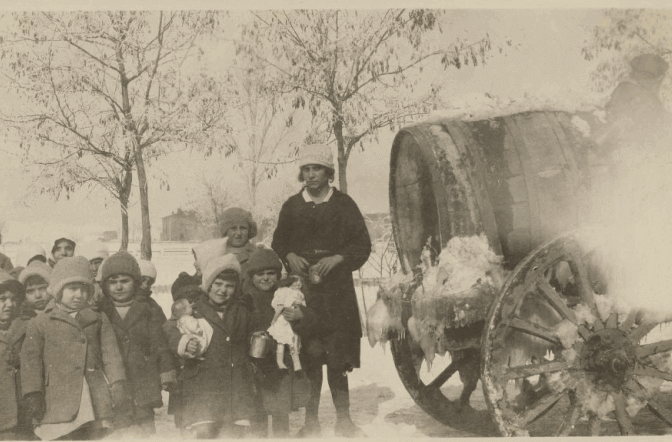Our History
Originally known as ‘The American Committee for Syrian and Armenian Relief’ and later ‘Near East Relief’, Near East Foundation (NEF) was founded in 1915 in response to a massive humanitarian crisis where millions of Armenians, Assyrians, Greeks and members of other minority groups were displaced, with over a million and a half dying as a result of deportation, forced marches, starvation and execution at the collapse of the Ottoman Empire.
The U.S. Ambassador to Turkey, Henry Morgenthau, sounded the alarm to the worsening humanitarian crisis. With the help of notable friends and colleagues, including President Woodrow Wilson, they launched a small-scale relief operation and began to solicit donations from the American public. These fundraising appeals – spearheaded by NEF’s first president, Cleveland H. Dodge – proved immensely successful and resulted in the largest non-governmental humanitarian response undertaken up until that time. In addition to emergency relief, orphanages, clinics and schools were established to support and save a generation of children orphaned by the crisis.
In 1930, there was a shift to focus on longer-term social and economic development and the Near East Foundation, as it is known today, was born. NEF has since worked through conflict and crises, partnering with communities across 50 countries to sustainably improve many millions of lives. Our collaborative approach to empowering local communities and building their capacity to become the agents of their own development has shaped the American philanthropic and humanitarian tradition, inspiring models like the Peace Corps, Truman’s Point Four program and USAID.
Today, NEF continues to help improve the livelihoods of the most vulnerable people in the region through grassroots, community-driven action.
Timeline Highlights
Cleveland H. Dodge leads the creation of the American Committee for Armenian and Syrian Relief (ACASR) after Henry Morgenthau, American Ambassador to the Ottoman Empire, sent a plea to help Armenians, Greeks and other minorities in the area who were forced from their homes following violent upheavals in the Ottoman Empire at the outbreak of World War I.
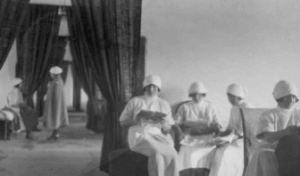
1915
ACASR officially becomes the Near East Relief after an act of Congress.
1919
Near East Relief raised $110 million to help refugees from the Ottoman Empire. This is equivalent to $1.25 billion today. Nearly one thousand men and women served overseas from 1915 to 1930. Thousands more volunteered throughout the country. Near East Relief efforts led to the building of scores of orphanages, vocational schools and food distributions centers and saved the lives of over a million Armenian, Greek and Syrian refugees, including 132,000 orphans.
1915-1930
NER shifts its focus from humanitarian relief to development and becomes the Near East Foundation.
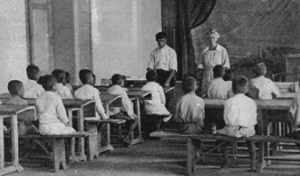
1930
The government of Iran invites NEF to create a rural improvement program based on its successful model in Greece. The program runs until 1979.
1946
President Truman creates the Point Four Program and cites NEF as a model. The United Nations Development Program, the United Nations Relief and Works Agency, and several other newly formed international assistance agencies acknowledge a debt to NEF as they embarked on development programs.
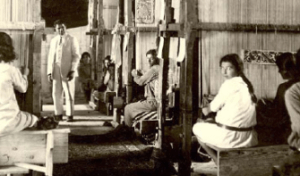
1950
In partnership with the recently created United States Agency for International Development (USAID), NEF begins to work in Africa–providing agricultural specialists for technical assistance projects.
1964
NEF becomes a granting agency to international development agencies such as the International Center for Research in Desert Agriculture in Syria, and the Desert Development Center in Cairo, Egypt. Technical assistance to USAID continues.
1970s
NEF begins to implement programs once again under its own name and expands to fifteen countries on an annual budget of $7 million. For most of the eighties, NEF’s program consists of three parts: standard technical assistance, grant giving to agricultural research centers, and rural/community level projects developed and managed by NEF specialists in cooperation with local organizations.
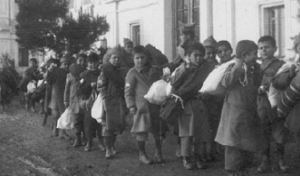
1980s
The Center for Development Services (CDS) in Cairo, Egypt, is established in 1990. Through CDS, NEF mobilizes local technical experts to provide training and technical assistance throughout the Middle East. NEF’s work is organized through country program offices in Egypt, Jordan, Lesotho, Mali, Morocco, the occupied Palestinian Territories, Sudan, and Swaziland.
1990s
NEF returns to work in Armenia after being forced out in 1927 by the Soviet Union.
2004
NEF headquarters makes a historic move to the campus of Syracuse University after NEF enters into a groundbreaking strategic affiliation with the university.
2010
NEF celebrates a century of relief and development in more than forty countries as our commitment to Sub-Saharan Africa expands. Our partnerships use our experience to develop methods in combating the effects of climate change in a significant way.
